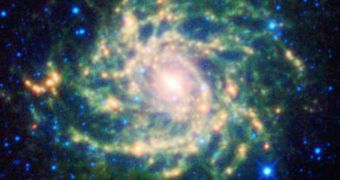The Milky Way is only one structure in a sea of galaxies permeating the Universe. Astronomers can peer through it at various wavelengths in order to look deep in the Cosmos, back to the time when it was only a few millions of years old. However, there are structures in our vicinity that cannot be observed in certain wavelengths, given that they are obscured by the dust and gas inside our own galaxy, or by the brightness of the stars in our galactic core. But some types of light can go through this “shield” and look immediately beyond our galaxy.
This is precisely what NASA's newly-launched Wide-field Infrared Survey Explorer (WISE) telescope did, when it used its infrared detectors to peer through the Milky Way's central regions. Its target is a spiral galaxy called IC 342, which astronomers know about, but that cannot be observed in visible light wavelengths. The structure is in fact oftentimes referred to by experts as the “hidden galaxy.” It is obscured by the thick clouds of dust in our galaxy's central regions, but this veil can easily be pierced by sensitive infrared telescopes such as WISE and Spitzer.
“This galaxy has been of great interest to astronomers because it is relatively close. However, determining its distance from Earth has proven difficult due to the intervening Milky Way. This image was made from observations by all four infrared detectors aboard WISE. Blue and cyan represent infrared light at wavelengths of 3.4 and 4.6 microns, which is primarily light from stars. Green and red represent light at 12 and 22 microns, which is primarily emission from warm dust,” experts at the NASA Jet Propulsion Laboratory (JPL) in Pasadena, California write of the new images on their official website.
Edwin Hubble, the world-famous astronomer after whom the orbital telescope is named, first proposed some time ago that the hidden galaxy was a part of our Local Group of galaxies. However, more recent observations, using advanced telescopes, determined that IC 342 is most likely located much farther away than Hubble calculated. New estimates place it a distance of between 6.6 and 11 million light-years away from the Milky Way. For comparison, our closest neighbor, the Andromeda galaxy, is some 2.5 million light-years away.

 14 DAY TRIAL //
14 DAY TRIAL //